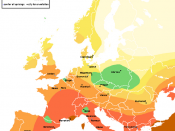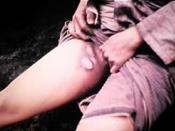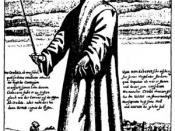The Black Death
1347-1351
Symptoms and Causes
There were three commonly seen forms of the Black Death. The bubonic plague, the pneumonic plague, and the septicemic plague. The bubonic plague was the most common; the symptoms included enlarged and inflamed lymph nodes (around arm pits, neck and groin), vomiting, headaches, fevers of 101-105 degrees Fahrenheit, and nausea. These symptoms took from 1-7 days to appear. The two other plagues were less common, probably because victims often died before they reached another place. Symptoms for the pneumonic plague included coughing up bloody mucus, because this form of plague infected the lungs. This form of Plague was especially dangerous since it could be transmitted through the air. The third plague, septicemic, was the most rare, and there is still no cure found for it. Victims suffered high fevers, and their skin usually turned a dark purple, this is where the term 'black death' got its name.
Victims often died the same day the symptoms died; in some towns as many as 800 died a day. The bubonic and septicemic were carried by fleas, who lived off the rats. They would bite a victim and regurgitate infected blood into the bloodstream.
Cures
There were many "cures" for the Black Death in the middle ages. Very few work, as no one knew that the majority of the plague was transmitted by fleas. People burned a great number of things to ward of the plague. They included juniper, laurel, pine, beech, lemon leaves, rosemary, camphor and sulfur. Church bells were rung at all times, as were cannons fired. Medieval people bought charms and spells and syrups from traveling salesmen who guaranteed that their cures would work. Some who could afford it wore long leather cloaks with hoods, and masks stuffed with herbs with...


